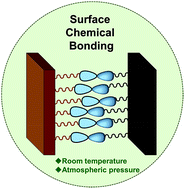Microfluidic device fabrication mediated by surface chemical bonding
Abstract
This review discusses various bonding strategies for fabricating microfluidic devices, with a special emphasis on the modification of the surface assisted by the use of chemicals to assemble microfluidic devices under mild conditions such as room temperature and atmospheric pressure. The paper includes an overview of the wide ranges of bonding methods used in the fabrication of microfluidic systems, such as anodic bonding, fusion bonding, thermal bonding, solvent bonding, and surface chemical bonding. Among these, surface chemical bonding plays a crucial role between the polydimethylsiloxane (PDMS) and thermoplastics in order to assemble a microfluidic device in a simple and facile manner. The first section reviews relevant research on the sealing for microfluidic devices; in the second section, the materials used for device fabrication are reviewed. The third section discusses the different sealing processes used in the fabrication of microfluidic devices on silicon, glass, thermoplastic, and elastomer. Overall, this review concludes with a discussion on the importance of the surface chemical modification for bonding an elastomer – PDMS – with rigid materials at room temperature under atmospheric pressure and detailed discussions on their bond strengths.



 Please wait while we load your content...
Please wait while we load your content...